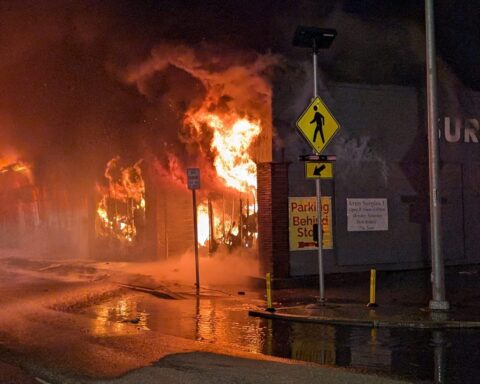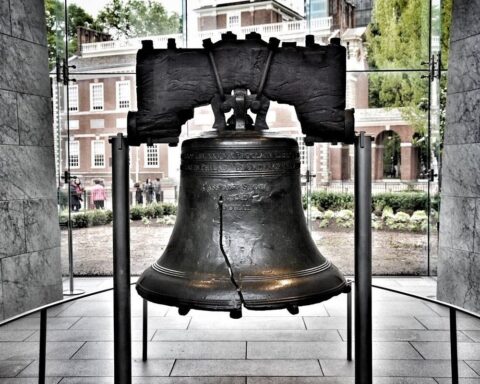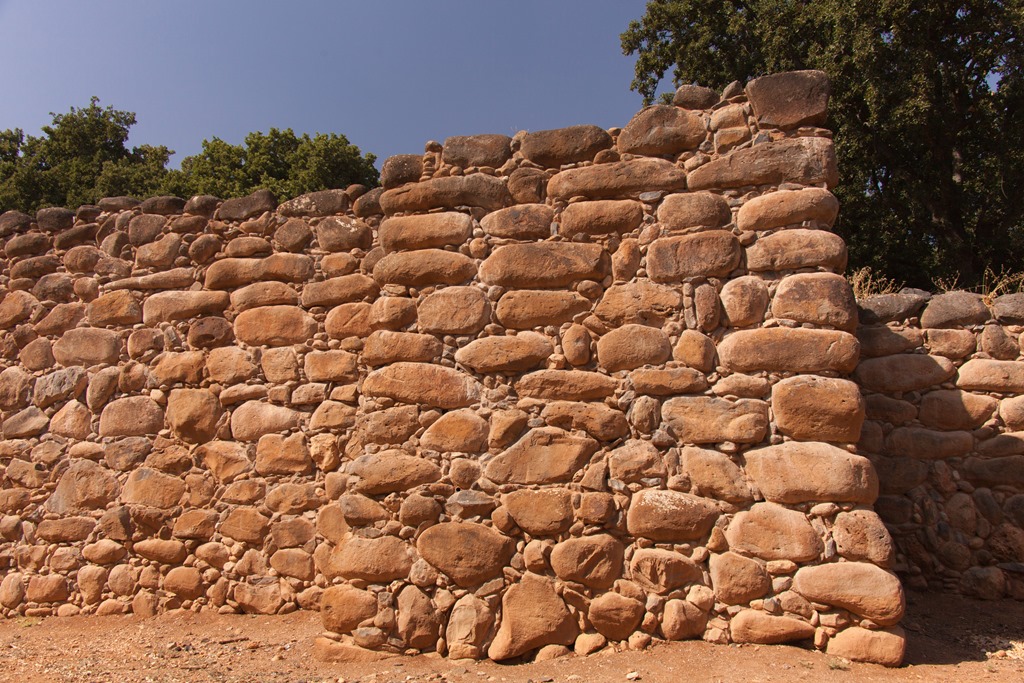(Continued from Part III)
Part IV – Turning Point
Because of its high and heavily-wooded western bank, the Big Blue was fordable in only three places along the six mile front taken up by the Army of the Border: Simmons’ Ford in the center, a cattle crossing known as Hinkle’s just north of it, and Byrom’s Ford furthest south. Jennison’s First Brigade took up positions in front of the latter on the specific orders of General Blunt, who kept the Second and Fourth behind to back up either Jennison or the militia, who were massed nearest the two northern fords. At first light, Jennison established pickets in front of the ford and sent four companies to nearby Hickman’s Mill to give warning of Price’s approach.
Pickets in front of all three crossings were fiercely driven in as Price tested first one defensive position and then another, but Byrom’s Ford proved to be the main focus of the Confederate attack on the mid-morning of October 22. General Shelby hit the ford straight on and deftly flanked Jennison’s exposed position on both left and right, successfully guiding much of his division across the Big Blue before Blunt had the chance to bring up more cavalry and militia for support.

The militia proved to be of little help in any case. One cavalry officer sent to reinforce Jennison found several squads of militia two miles behind Jennison’s position, falling back in confusion. While he was able to turn them around, other officers had to resort to drawing their weapons to turn fleeing militiamen back toward the battle. When they finally joined Jennison’s lines, which were by then pulling back in the face of Shelby’s advance, Shelby easily captured several hundred of them.
The Fifteenth, who had held their position for several hours before Shelby’s forces threatened to cut them off completely, was driven back toward Westport, a small settlement near Kansas City. From three in the afternoon, Shelby pushed them steadily backward until by the time night fell, he was directly south of their position, from where he withdrew back across Brush Creek for the night.
Because it started so late in the morning, the Battle of the Big Blue had stretched a short but fierce blocking action by Jennison into a whole day’s delay for Price. If that were not frustrating enough for the general, Price now found it impossible to exploit the breaththrough as much as he had to defend it. Because Blunt’s tiny cavalry had slowed his progress to a crawl, Pleasonton’s cavalry was beginning to engage General Marmaduke’s scouts in Price’s rear. Now two armies troubled Price, forcing him to decide quickly how to deal with one of them before they could join up or surround him. He decided to hit Blunt’s cavalry at first light. Then having dispensed with them, he could turn his full attention to the riders charging up from behind.
On the north side of the creek that separated the Union and Confederate armies, two things troubled Colonel Jennison as well: a good portion of the militia, which was supposed to be his cavalry’s backup, had retreated to Kansas without a fight, and Major John Laing, with companies B, C, F, and M of the Fifteenth, had disappeared without a trace.
Laing’s job that morning had seemed simple enough. Ordered by Jennison to take up a forward position at Hickman’s Mills, Missouri, to scout Price’s advance and to fall back toward Kansas if he was cut off, Laing and his men arrived in that town about ten in the morning. Price’s men had been there at dawn and had apparently raised a few recruits and collected some arms, but there was no sight of Confederate troops in the immediate vicinity.
Shortly after their arrival, Lieutenant Cyrus M. Roberts, acting aid-de-camp for General Curtis, approached Major Laing to inform him that they were to return at once to support Jennison’s stand against Shelby’s advance. The message Laing received was different or at least interpreted differently: he thought Price was in full retreat and they were to join Union forces in pursuit of him. Laing immediately ordered the detachment to mount and head out. Shortly after noon the four companies, with Major Laing in the lead, trotted down the Little Santa Fe Road toward Olathe, Kansas, fifteen miles to the west.
They had not traveled far before the men of the Fifteenth began to see things that made them wonder if Price had been routed after all. The Second and then the Twenty-First Kansas militias crossed their path, or rather burst upon it; both units were in full retreat. The marchers could clearly hear the sounds of big guns, but only in their rear, back to the east. Finally they began to gather rumors from people on the road that Price had burst through at the Big Blue and had advanced all the way to Shawnee, Kansas, ten miles to their north. Upon their near-midnight arrival in Olathe, evidence before their eyes suggested to them that their orders had come not from General Curtis but from a spy: small groups of civilians and larger squads of militia were passing through Olathe from the direction of Shawnee . Laing decided to wait for morning, hoping for word of an expected meetup of the routed Union troops.
Before sunrise, Laing led his bewildered command northward, toward Wyandotte, where he expected a beaten Union army would gather for another stand. Hoping to avoid the rumored Confederate picket of 1,000 men that was waiting for him outside Shawnee, Laing’s squad swung wide and to the west and crossed the Kaw River on the northwest side of Shawnee, finally reaching Wyandotte late in the day. They were hurriedly sent back to Westport, just in time to re-join the rest of the Fifteenth on its march toward Fort Scott in pursuit of Price. Major Laing was arrested immediately upon his arrival : he and his men had missed the Battle of Westport completely.
The rest of the Fifteenth could be forgiven for any animosity they harbored concerning Laing’s unfortunate roundabout. The morning he trotted out of Olathe, they found themselves awakened five hours before sunrise to take up positions on the north side of Brush Creek, the last moving water between Price’s Army and Kansas City, where the remaining body of Kansas militia waited behind their hastily-improved fortifications. The entire First Division of the Army of the Border, the official way of denoting the same three cavalry brigades that had fought Price three of the last four days, was sent forward to meet what they expected to be Price’s full army. As they noted the Confederates advancing toward their position, they reflected upon the difference an extra three hundred men in their thin lines might have made.
In contrast to the day prior when Price’s men had raised recruits before the battle, the morning of October 23 they went on the attack early. Dispatching Marmaduke’s division to hold Byram’s Ford, Price sent Shelby’s cavalry, with some assistance from the division of Major General James F. Fagan, to smash Blunt before he was pinned between the two armies. As a precaution, he also sent his enormous baggage train southward on the Fort Scott Road. Win or lose, Price was out of time to invade Kansas, at least at Leavenworth.
The banks on either side of Brush Creek were loosely forested, thick in some places but not enough so to hide the large columns of advancing soldiers that could be clearly seen from several hilltops between Westport and Kansas City. The hills that sloped toward the creek lay open in many places, dotted with fields and crisscrossed by stone fences. With a position that held none of the defensive advantages he had enjoyed the day before at the Big Blue, General Curtis ordered Blunt’s cavalry, waiting on the north side of the creek, to take the fight to Shelby as soon as his forces appeared from the trees to their south.
The Battle of Westport, which began at first light, raged for four hours, back and forth. The repeated charges of the Fifteenth, led by Hoyt, “dashed forward with a terrible shout, carrying the heights and stone fences,” only to be driven back each time as Shelby’s overwhelming numbers came into play. Jennison led repeated charges with the other companies of the First on Shelby’s left flank, yet twice Shelby’s broken lines reformed. However, during the morning stalemate, a 75-year-old Missouri native revealed to Union forces a hidden route whereby they could place the guns of Dodge’s Ninth Wisconsin Battery on Shelby’s right flank from the south side of Brush Creek. Hearing Dodge’s guns to his right and now Pleasonton’s on his left, and with Kansas militia reinforcements pouring onto the field to belatedly support Blunt’s cavalry, General Curtis personally ordered Jennison to make a mounted charge. Shelby, at the same moment, received an order to support Marmaduke toward the fords of the Big Blue.
The appointed charge led straight up the road that ran from Independence to Westport, right into the center of Shelby’s slowly retreating line. Jennison, leading one company of the Fifteenth, General Blunt’s bodyguard, and companies from Colorado and Wisconsin, advanced on its right side. Hoyt, with the remaining six companies of the Fifteenth, galloped along the left. The charge proved irresistible, and as it rolled into Shelby lines, Shelby’s backed into the retreating command of Marmaduke, who had finally been dislodged from Byram’s Ford by Pleasonton. The withdrawal quickly became a rout, with Price’s broken lines now pinned between two newly-joined Union forces and seeking the fastest way to get their men and their baggage train south.
Jennison and his First Brigade pursued the retreating Shelby for about 10 miles to a ford further south on the Big Blue, across which Fagan opened on them with his big guns. Then they marched back to the Union lines at Westport for some needed rest. The Fifteenth had fought four battles in five days.
As the immediate danger to Kansas looked to be past, the remaining militia from its northern counties wished to strike for home without delay or pursuit, as did many of the Missouri volunteers, who also desired to be home for election day. None of the senior officers knew the night after Westport what forces they had to chase Price, and few of them, exhausted as they were, wished to do so immediately.
(Continued in Part V)

Tarnished Brass – A History of the Kansas Fifteenth Volunteer Cavalry, Part IV
Latest from History

Dangerous Left Wing Rhetoric
On Saturday, July 13, 2024, an assassin came within inches of murdering Donald Trump on a live broadcast. Democrat talking heads immediately split into two camps: some said Trump staged the shooting

Revolution, Independence, and Union – Part 6
The good effects of the American revolt on British politics have it would seem been overrated. Whatever Chatham or any one else might say in his oratoric mood, there was little danger

Revolution, Independence, and Union – Part 5
It was in the dark hour before the arrival of French aid that treason entered into the heart of Benedict Arnold, the commander of the all-important lines upon the Hudson. Arnold had

Revolution, Independence, and Union – Part 4
The Netherlands, when they rose against Spain and the Inquisition, had a cause terribly great and showed spirit as great as their cause. The cause in which the Americans rose against the

Revolution, Independence, and Union – Part 3
The war opened at Boston, where General Gage, now its military governor, lay with a small army of occupation and repression, and it opened in a way ominous of the final result



